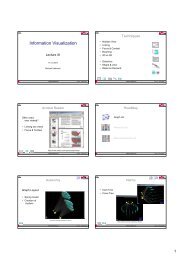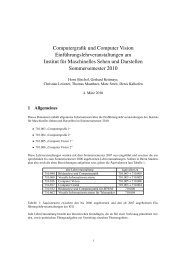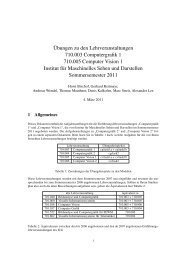- Page 1: Lehrveranstaltungsinhalt aus ” Bi
- Page 4 and 5: 4 CONTENTS 2 Sensing 51 2.1 The Mos
- Page 6 and 7: 6 CONTENTS 8 Texture 151 8.1 Descri
- Page 8 and 9: 8 CONTENTS 12 Interaction of Light
- Page 10 and 11: 10 CONTENTS A Algorithmen und Defin
- Page 12 and 13: 12 CHAPTER 0. INTRODUCTION 2. It de
- Page 14 and 15: 14 CHAPTER 0. INTRODUCTION The five
- Page 16 and 17: 16 CHAPTER 0. INTRODUCTION case “
- Page 18 and 19: 18 CHAPTER 0. INTRODUCTION 0.13 Non
- Page 20 and 21: 20 CHAPTER 0. INTRODUCTION square a
- Page 22 and 23: 22 CHAPTER 0. INTRODUCTION made”.
- Page 24 and 25: 24 CHAPTER 0. INTRODUCTION
- Page 26 and 27: 26 CHAPTER 0. INTRODUCTION Slide 0.
- Page 28 and 29: 28 CHAPTER 0. INTRODUCTION Slide 0.
- Page 30 and 31: 30 CHAPTER 0. INTRODUCTION
- Page 32 and 33: 32 CHAPTER 0. INTRODUCTION Slide 0.
- Page 34 and 35: 34 CHAPTER 0. INTRODUCTION Slide 0.
- Page 36 and 37: 36 CHAPTER 0. INTRODUCTION
- Page 38 and 39: 38 CHAPTER 1. CHARACTERIZATION OF I
- Page 42 and 43: 42 CHAPTER 1. CHARACTERIZATION OF I
- Page 44 and 45: 44 CHAPTER 1. CHARACTERIZATION OF I
- Page 46 and 47: 46 CHAPTER 1. CHARACTERIZATION OF I
- Page 48 and 49: 48 CHAPTER 1. CHARACTERIZATION OF I
- Page 50 and 51: 50 CHAPTER 1. CHARACTERIZATION OF I
- Page 52 and 53: 52 CHAPTER 2. SENSING from three co
- Page 54 and 55: 54 CHAPTER 2. SENSING 0 (the perspe
- Page 56 and 57: 56 CHAPTER 2. SENSING So to create
- Page 58 and 59: 58 CHAPTER 2. SENSING 2.7 Multispec
- Page 60 and 61: 60 CHAPTER 2. SENSING obtains a con
- Page 62 and 63: 62 CHAPTER 2. SENSING arrangement.
- Page 64 and 65: 64 CHAPTER 2. SENSING
- Page 66 and 67: 66 CHAPTER 2. SENSING Slide 2.29 Sl
- Page 68 and 69: 68 CHAPTER 2. SENSING
- Page 70 and 71: 70 CHAPTER 3. RASTER-VECTOR-RASTER
- Page 72 and 73: 72 CHAPTER 3. RASTER-VECTOR-RASTER
- Page 74 and 75: 74 CHAPTER 3. RASTER-VECTOR-RASTER
- Page 76 and 77: 76 CHAPTER 3. RASTER-VECTOR-RASTER
- Page 78 and 79: 78 CHAPTER 3. RASTER-VECTOR-RASTER
- Page 80 and 81: 80 CHAPTER 4. MORPHOLOGY Definition
- Page 82 and 83: 82 CHAPTER 4. MORPHOLOGY 1 2 3 Form
- Page 84 and 85: 84 CHAPTER 4. MORPHOLOGY Formelemen
- Page 86 and 87: 86 CHAPTER 4. MORPHOLOGY Definition
- Page 88 and 89: 88 CHAPTER 4. MORPHOLOGY window wit
- Page 90 and 91:
90 CHAPTER 4. MORPHOLOGY Slide 4.1
- Page 92 and 93:
92 CHAPTER 4. MORPHOLOGY
- Page 94 and 95:
94 CHAPTER 5. COLOR A monitor prese
- Page 96 and 97:
96 CHAPTER 5. COLOR Color in image
- Page 98 and 99:
98 CHAPTER 5. COLOR 3. Any point in
- Page 100 and 101:
100 CHAPTER 5. COLOR Definition 14
- Page 102 and 103:
102 CHAPTER 5. COLOR Antwort: es is
- Page 104 and 105:
104 CHAPTER 5. COLOR Algorithm 11 C
- Page 106 and 107:
106 CHAPTER 5. COLOR Algorithm 13 C
- Page 108 and 109:
108 CHAPTER 5. COLOR Algorithm 15 C
- Page 110 and 111:
110 CHAPTER 5. COLOR grün gelb cya
- Page 112 and 113:
112 CHAPTER 5. COLOR gray values ar
- Page 114 and 115:
114 CHAPTER 5. COLOR In Slide 5.81
- Page 116 and 117:
116 CHAPTER 5. COLOR Slide 5.1 Slid
- Page 118 and 119:
118 CHAPTER 5. COLOR Slide 5.57 Sli
- Page 120 and 121:
120 CHAPTER 5. COLOR
- Page 122 and 123:
122 CHAPTER 6. IMAGE QUALITY Resolv
- Page 124 and 125:
124 CHAPTER 6. IMAGE QUALITY Algori
- Page 126 and 127:
126 CHAPTER 6. IMAGE QUALITY An exa
- Page 128 and 129:
128 CHAPTER 6. IMAGE QUALITY (a) du
- Page 130 and 131:
130 CHAPTER 6. IMAGE QUALITY Slide
- Page 132 and 133:
132 CHAPTER 6. IMAGE QUALITY
- Page 134 and 135:
134 CHAPTER 7. FILTERING 7.2 Low-Pa
- Page 136 and 137:
136 CHAPTER 7. FILTERING 7.3 The Fr
- Page 138 and 139:
¡ ¡ ¡ ¡ ¡ ¡ ¡ ¡ ¡ ¡ ¡ ¡
- Page 140 and 141:
140 CHAPTER 7. FILTERING 9 9 8 8 6
- Page 142 and 143:
142 CHAPTER 7. FILTERING appearance
- Page 144 and 145:
144 CHAPTER 7. FILTERING Getting An
- Page 146 and 147:
146 CHAPTER 7. FILTERING
- Page 148 and 149:
148 CHAPTER 7. FILTERING Slide 7.29
- Page 150 and 151:
150 CHAPTER 7. FILTERING
- Page 152 and 153:
152 CHAPTER 8. TEXTURE µ n (z) =
- Page 154 and 155:
154 CHAPTER 8. TEXTURE Algorithm 23
- Page 156 and 157:
156 CHAPTER 8. TEXTURE now need to
- Page 158 and 159:
158 CHAPTER 8. TEXTURE Slide 8.1 Sl
- Page 160 and 161:
160 CHAPTER 8. TEXTURE
- Page 162 and 163:
162 CHAPTER 9. TRANSFORMATIONS In t
- Page 164 and 165:
164 CHAPTER 9. TRANSFORMATIONS = =
- Page 166 and 167:
166 CHAPTER 9. TRANSFORMATIONS Defi
- Page 168 and 169:
168 CHAPTER 9. TRANSFORMATIONS prop
- Page 170 and 171:
170 CHAPTER 9. TRANSFORMATIONS Ther
- Page 172 and 173:
172 CHAPTER 9. TRANSFORMATIONS clip
- Page 174 and 175:
174 CHAPTER 9. TRANSFORMATIONS coor
- Page 176 and 177:
176 CHAPTER 9. TRANSFORMATIONS to d
- Page 178 and 179:
178 CHAPTER 9. TRANSFORMATIONS If w
- Page 180 and 181:
180 CHAPTER 9. TRANSFORMATIONS 9.16
- Page 182 and 183:
182 CHAPTER 9. TRANSFORMATIONS to t
- Page 184 and 185:
184 CHAPTER 9. TRANSFORMATIONS kubi
- Page 186 and 187:
186 CHAPTER 9. TRANSFORMATIONS Algo
- Page 188 and 189:
188 CHAPTER 9. TRANSFORMATIONS
- Page 190 and 191:
190 CHAPTER 9. TRANSFORMATIONS Slid
- Page 192 and 193:
192 CHAPTER 9. TRANSFORMATIONS Slid
- Page 194 and 195:
194 CHAPTER 9. TRANSFORMATIONS Slid
- Page 196 and 197:
196 CHAPTER 10. DATA STRUCTURES the
- Page 198 and 199:
198 CHAPTER 10. DATA STRUCTURES lik
- Page 200 and 201:
200 CHAPTER 10. DATA STRUCTURES nur
- Page 202 and 203:
202 CHAPTER 10. DATA STRUCTURES Pr
- Page 204 and 205:
204 CHAPTER 10. DATA STRUCTURES Alg
- Page 206 and 207:
206 CHAPTER 10. DATA STRUCTURES
- Page 208 and 209:
208 CHAPTER 10. DATA STRUCTURES Sli
- Page 210 and 211:
210 CHAPTER 10. DATA STRUCTURES
- Page 212 and 213:
212 CHAPTER 11. 3-D OBJECTS AND SUR
- Page 214 and 215:
214 CHAPTER 11. 3-D OBJECTS AND SUR
- Page 216 and 217:
216 CHAPTER 11. 3-D OBJECTS AND SUR
- Page 218 and 219:
218 CHAPTER 11. 3-D OBJECTS AND SUR
- Page 220 and 221:
220 CHAPTER 11. 3-D OBJECTS AND SUR
- Page 222 and 223:
222 CHAPTER 11. 3-D OBJECTS AND SUR
- Page 224 and 225:
224 CHAPTER 12. INTERACTION OF LIGH
- Page 226 and 227:
226 CHAPTER 12. INTERACTION OF LIGH
- Page 228 and 229:
228 CHAPTER 12. INTERACTION OF LIGH
- Page 230 and 231:
230 CHAPTER 12. INTERACTION OF LIGH
- Page 232 and 233:
232 CHAPTER 12. INTERACTION OF LIGH
- Page 234 and 235:
234 CHAPTER 12. INTERACTION OF LIGH
- Page 236 and 237:
236 CHAPTER 13. STEREOPSIS entsprec
- Page 238 and 239:
238 CHAPTER 13. STEREOPSIS unintend
- Page 240 and 241:
240 CHAPTER 13. STEREOPSIS verify t
- Page 242 and 243:
242 CHAPTER 13. STEREOPSIS
- Page 244 and 245:
244 CHAPTER 13. STEREOPSIS Slide 13
- Page 246 and 247:
246 CHAPTER 14. CLASSIFICATION Prü
- Page 248 and 249:
248 CHAPTER 14. CLASSIFICATION the
- Page 250 and 251:
250 CHAPTER 14. CLASSIFICATION As s
- Page 252 and 253:
252 CHAPTER 14. CLASSIFICATION
- Page 254 and 255:
254 CHAPTER 14. CLASSIFICATION Slid
- Page 256 and 257:
256 CHAPTER 15. RESAMPLING images,
- Page 258 and 259:
258 CHAPTER 15. RESAMPLING • Gege
- Page 260 and 261:
260 CHAPTER 15. RESAMPLING Slide 15
- Page 262 and 263:
262 CHAPTER 16. ABOUT SIMULATION IN
- Page 264 and 265:
264 CHAPTER 16. ABOUT SIMULATION IN
- Page 266 and 267:
266 CHAPTER 17. MOTION allows one t
- Page 268 and 269:
268 CHAPTER 17. MOTION
- Page 270 and 271:
270 CHAPTER 18. MAN-MACHINE-INTERFA
- Page 272 and 273:
272 CHAPTER 19. PIPELINES 19.3 Revi
- Page 274 and 275:
274 CHAPTER 19. PIPELINES
- Page 276 and 277:
276 CHAPTER 20. IMAGE REPRESENTATIO
- Page 278 and 279:
278 CHAPTER 20. IMAGE REPRESENTATIO
- Page 280 and 281:
280 CHAPTER 20. IMAGE REPRESENTATIO
- Page 282 and 283:
282 CHAPTER 20. IMAGE REPRESENTATIO
- Page 284 and 285:
284 CHAPTER 20. IMAGE REPRESENTATIO
- Page 286 and 287:
286 APPENDIX A. ALGORITHMEN UND DEF
- Page 288 and 289:
288 APPENDIX A. ALGORITHMEN UND DEF
- Page 290 and 291:
290 APPENDIX B. FRAGENÜBERSICHT
- Page 292 and 293:
292 APPENDIX B. FRAGENÜBERSICHT
- Page 294 and 295:
294 APPENDIX B. FRAGENÜBERSICHT 12
- Page 296 and 297:
296 APPENDIX B. FRAGENÜBERSICHT
- Page 298 and 299:
298 APPENDIX B. FRAGENÜBERSICHT
- Page 300 and 301:
300 APPENDIX B. FRAGENÜBERSICHT (a
- Page 302 and 303:
302 APPENDIX B. FRAGENÜBERSICHT Fi
- Page 304 and 305:
304 APPENDIX B. FRAGENÜBERSICHT 10
- Page 306 and 307:
306 APPENDIX B. FRAGENÜBERSICHT 1
- Page 308 and 309:
308 APPENDIX B. FRAGENÜBERSICHT 3
- Page 310 and 311:
310 APPENDIX B. FRAGENÜBERSICHT R
- Page 312 and 313:
312 APPENDIX B. FRAGENÜBERSICHT A
- Page 314 and 315:
314 APPENDIX B. FRAGENÜBERSICHT y
- Page 316 and 317:
316 APPENDIX B. FRAGENÜBERSICHT gr
- Page 318 and 319:
318 APPENDIX B. FRAGENÜBERSICHT Fi
- Page 320 and 321:
320 APPENDIX B. FRAGENÜBERSICHT (a
- Page 322 and 323:
322 APPENDIX B. FRAGENÜBERSICHT (a
- Page 324 and 325:
324 APPENDIX B. FRAGENÜBERSICHT Fi
- Page 326 and 327:
326 APPENDIX B. FRAGENÜBERSICHT 0
- Page 328 and 329:
328 APPENDIX B. FRAGENÜBERSICHT Fi
- Page 330 and 331:
330 APPENDIX B. FRAGENÜBERSICHT B
- Page 332 and 333:
332 APPENDIX B. FRAGENÜBERSICHT Fi
- Page 334 and 335:
334 APPENDIX B. FRAGENÜBERSICHT Fi
- Page 336 and 337:
336 APPENDIX B. FRAGENÜBERSICHT Fi
- Page 338 and 339:
338 APPENDIX B. FRAGENÜBERSICHT (a
- Page 340 and 341:
340 APPENDIX B. FRAGENÜBERSICHT Fi
- Page 342 and 343:
342 APPENDIX B. FRAGENÜBERSICHT 1
- Page 344 and 345:
344 APPENDIX B. FRAGENÜBERSICHT zu
- Page 346 and 347:
346 APPENDIX B. FRAGENÜBERSICHT
- Page 348 and 349:
348 APPENDIX B. FRAGENÜBERSICHT (a
- Page 350 and 351:
350 APPENDIX B. FRAGENÜBERSICHT ¡
- Page 352 and 353:
352 INDEX Entzerrung, 287 Erosion,
- Page 354 and 355:
354 INDEX Skalierung, 157, 303 Sobe
- Page 356 and 357:
356 LIST OF ALGORITHMS 29 z-buffer
- Page 358 and 359:
358 LIST OF DEFINITIONS 29 Boundary
- Page 360 and 361:
360 LIST OF FIGURES B.12 Lineare Tr
- Page 362 and 363:
362 LIST OF FIGURES












